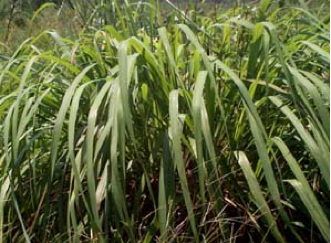Serai Wangi
| Serai Wangi | |
| Scientific name | Cymbopogon nardus (L.) rendle |
| Common name | Citronella, Serai wangi (Malay) |
| Family | Graminae |
| Synonyms | Andropogon confertiflorus |
 |
{slider=Geographical & Distribution}
Citronella grows wildly in many tropical countries of Asia, America and Africa. In Malaysia, it is normally cultivated in home gardens. Citronella is a very hardly crop and can be adapted to a variety of soil and climatic conditions. However, it thrives on well-aerated soils with good fertility. This crops cannot withstand water-logged conditions and shade; therefore open areas are best suited for its cultivation.
{/slider}
{slider=General Appearance}
Citronella is a tall fragrant perennial grass, throwing out dense fascicles of leaves from a stout rhizome. It can grow up to a height of 1-1.5m. The leaves are sessile , simple, green, linear, equitantly arranged and can grow to an average size of 60cm long x 2.5 cm wide. The leaf isglabrous, venation parallel with an acuminate apice and sheathing base. The leaf sheath is tubular and acts as a pseudostem.The rhizome is stout, creeping, robust and creamish yellow in section . It produces clumpled bulbous stems that become leaf blades and branched clusters of stalked flowers.
{/slider}
{slider=Plant Part Used}
Leaves.Propagated by dividing into small clumps and planted in the soil
{/slider}
{slider=Traditional Uses}
Citronella oil is used as a rubefacient. The roots are diuretic and sudorific. It is a mosquito repellent and is used in perfumery and soap-making. In Malaysia, the volatile oil of Citronella is given in small doses to confort the stomach and to aid digestion. A decoction of the citronella leaves with Gendarusa and betel-pepper is being used as an after childbirth wash.E.o effective against Anopheles stephesi larvae, carrier of malaria fever.
{/slider}
{slider=Chemical Contents}
Essential oils: citronellal, citronellol, limonene, geranial and feraniol. Citronellal was the main essential oil component in the matured plants (Chan L.K. et al 2005). Alpha-cubebene, camphene, geraniol, limonene, myrcene, palmitic acid and sabinen were the major compounds identified. The essential oil was investigated for its antioxidant (DPPH assay), anti-inflammatory (5-lipoxygenase assay), antimicrobial (disk diffusion) and anti-mosquito properties (insecticidal, larvicidal and repellency assays) (Naidoo N ,et al, 2008)
{/slider}
{slider=Research}
Anti-malaria
The oil showed poor antimicrobial activity and inhibited the growth of Bacillus, Micrococcus and Staphylococcus with a minimum inhibitory concentration of 0.0625 (vol/vol). The oil showed antioxidant activity, scavenging more than 80% of DPPH free radicals and did not show any anti-inflammatory activity. It also showed good adulticidal activity (53.7% mortality) and excellent larvicidal (100% mortality) and repellent activity (100% repellency) against Anopheles arabiensis mosquitoes, which are malarial vectors. The results of this study show that the essential oil from C. nardus possesses, antioxidant, antibacterial and anti-mosquito activities which may be associated with its predominant compounds viz., α-cubebene, camphene, geraniol, limonene, myrcene, palmitic acid and sabinen. These results lead the way for exploiting C. nardus oil as a multi-functional agent. (Naidoo N ,et al, 2008)
Anti Fungi
Mycellium growth of Aspergullus niger were completely inhibited at 800 mg/mL. Essential oil at 400 mg/mL caused growth inhibition of 80 % after 4 days of incubation (Billerbeck VG, et al, 2001).
Repellents
Citronella oil has demonstrated good efficacy against 44 mosquitoes in concentrations ranging from 0.05 % to 15 % (w/v) alone or in combination with other natural or commercial insect repellent products (Sakulku et al., 2009 apud Fradin, 1998). Olivo et al. (2008) apud Shasany et al. (2000) confirmed that this characteristic of the oil is due to the presence of four main components, citronelal, eugenol, geraniol and limonene (Silva C.F. 2011).
{/slider}
{slider=Reference}
Billerbeck VG, C. G. Roques, JM. Bessiere, JL. Fonvielle & R. Dargent (2001). Effects of Cymbopogon nardus (L.) W. Watson essential oil on the growth and morphogenesis of Aspergillus niger. Canadian Journal of Microbiology 47, (1), 9-17.
Chan L.K, P.R. Dewi & P.L Boey (2005). Effects of Plant Growth Regulators on Regeneration of Plantlets from Bud Culteres of Cymbopogon nardus L. The Detection of Essential oils from the in Vitro Plantlets. Journal of Plant Biology 48 (1) Pg 142-146.
Naidoo N , K. Thangaraj , B. Odhav and H. Baijnath (2008). African Journal of Traditional, Complementary and Alternative medicines (AJTCAM), Abstract of The World Congress on Medicinal and Aromatic Plants, Cape Town.
Silva C.F., F.C. Maoura, M.F. Mendes & F.L. P. Pessoa (2011). Extraction of Citronella (Cymbopogon nardus) essential oil using supercritical CO2: Experimental data and mathematical modeling. Brazilian Journal of Chemical Enginneering Vol 28 (2).
{/slider}
- Last updated on .
- Hits: 8529
